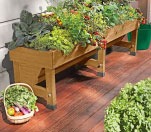Raised garden beds are an increasingly popular option for gardening enthusiasts looking to maximize their growing space and create efficient and productive gardens. These elevated planting areas offer several benefits that make them an attractive choice for both novice and experienced gardeners. Here are some advantages of using raised garden beds:
Improved Soil Quality: Raised garden beds allow you to have more control over the soil quality in your garden. You can fill the beds with a customized soil mix, combining compost, topsoil, and other organic matter. This creates a rich and fertile growing environment, ensuring optimal nutrient levels and drainage for your plants. It also reduces the risk of compacted or poor-quality soil that may hinder plant growth.
Better Drainage: The elevated design of raised garden beds promotes excellent drainage, preventing waterlogging and excess moisture. Excess water drains away more efficiently, reducing the risk of root rot and other water-related plant diseases. Better drainage also allows for an extended growing season, as the soil warms up faster in spring, and excess rainwater is quickly drained away.
Weed Control: Raised garden beds offer natural weed control. By creating a defined and contained planting area, you can easily manage and suppress weed growth. The raised bed structure helps prevent weed seeds from blowing or spreading into the growing area, reducing the amount of time and effort required for weeding and minimizing competition for nutrients and water.
Pest and Animal Protection: Raised garden beds can help protect your plants from pests and animals. The elevated height makes it more difficult for ground-dwelling pests, such as snails or slugs, to access the plants. You can also add physical barriers like mesh or netting to further deter pests and prevent animals from digging or nibbling on your crops.
Extended Growing Season: Raised garden beds tend to warm up faster in the spring, as the soil is exposed to more sunlight and has better drainage. This enables you to start planting earlier and extend your growing season. Additionally, you can cover the beds with protective materials, such as row covers or plastic tunnels, to create a mini-greenhouse effect and prolong the growing season even further.
Accessibility: The raised height of the garden beds makes gardening more accessible and comfortable, especially for individuals with physical limitations. Bending and kneeling are reduced, minimizing strain on the back and joints. This accessibility feature is particularly beneficial for older gardeners or those with mobility issues, allowing them to continue gardening with ease.
Aesthetically Pleasing: Raised garden beds add an attractive and organized element to your garden. They provide a defined structure and can be built in various shapes, sizes, and heights to suit your preferences and garden design. The raised beds create visually appealing focal points and can be incorporated into existing landscaping or used to create a dedicated garden area.
Space Optimization: Raised garden beds optimize space utilization, particularly in small or limited areas. They allow you to grow more plants in a smaller footprint by maximizing the use of vertical space. You can easily add trellises, stakes, or cages to support climbing or vining plants, further increasing your growing capacity.
Soil Erosion Prevention: In sloped or hilly areas, raised garden beds help prevent soil erosion. The elevated structure holds the soil in place and reduces the risk of soil runoff during heavy rains. This is especially beneficial for areas prone to erosion or where the topsoil is thin.


When planning your raised garden beds, consider factors such as the desired height and dimensions, materials for construction (such as wood, stone, or metal), and the amount of sunlight the location receives. It's also important to choose appropriate plants for your raised beds based on their sunlight requirements, root depth, and compatibility with neighboring plants.

 0
0
 English
English 中文简体
中文简体 Français
Français Español
Español
















